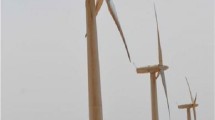Abstract
In this study, long-term vibration-based monitoring of a 900-kW onshore wind turbine is presented. Modal properties such as frequency, shape, and damping ratios were obtained using enhanced frequency domain decomposition method. Change in modal parameters due to environmental and operational conditions was determined. Modal parameters after cleansing such effects were obtained by multiple linear regression analyses. Then, finite element model of the wind turbine was developed including piles and soil springs; and updated using identified modal parameters. After all, seismic fragility curves of the structure with the limit state being local buckling were developed considering different levels of wind speed. Stress level at which local buckling occurs was determined by pushover analysis of the turbine using a nonlinear finite element model. In the context of this study, it was observed that identified modal values had significant scattering and level of wind speed significantly changed the seismic fragility curve of the wind turbine.


















Similar content being viewed by others
References
Hansen MH, Thomsen K, Fuglsang P, Knudsen T (2006) Two methods for estimating aeroelastic damping of operational wind turbine modes from experiments. Wind Energy 9(1–2):179–191
Devriendt C, Magalhães F, Weijtjens W, De Sitter G, Cunha Á, Guillaume P (2014) Structural health monitoring of offshore wind turbines using automated operational modal analysis. Struct Health Monit 13(6):644–659
Oliveira G, Magalhaes F, Cunha A, Caetano E (2016) Development and implementation of a continuous dynamic monitoring system in a wind turbine. J Civ Struct Health Monit 6(3):343–353
Oliveira G, Magalhaes F, Cunha A, Caetano E (2018) Continuous dynamic monitoring of an onshore wind turbine. Eng Struct 164:22–39
Hu WH, Thöns S, Rohrmann RG, Said S, Rücker W (2015) Vibration-based structural health monitoring of a wind turbine system. Part I: resonance phenomenon. Eng Struct 89:260–272
Hu WH, Thöns S, Rohrmann RG, Said S, Rücker W (2015) Vibration-based structural health monitoring of a wind turbine system. Part II: environmental/operational effects on dynamic properties. Eng Struct 89:273–290
Oliveira G, Magalhaes F, Cunha A, Caetano E (2018) Vibration-based damage detection in a wind turbine using 1 year of data. Struct Control Health Monit 25(11):e2238
Katsanos EI, Thöns S, Georgakis CT (2016) Wind turbines and seismic hazard: a state of the art review. Wind Energy 19:2113–2133
Diaz O, Suarez LE (2014) Seismic analysis of wind turbines. Earthq Spectra 30(2):743–765
Patil A, Jung S, Kwon OS (2016) Structural performance of a parked wind turbine tower subjected to strong ground motions. Eng Struct 120:92–102
Bazeos N, Hatzigeorgiou GD, Hondros ID, Karamaneas H, Karabalis DL, Beskos DE (2002) Static, seismic and stability analyses of a prototype wind turbine steel tower. Eng Struct 24(8):1015–1025
Nuta E, Christopoulos C, Packer JA (2011) Methodology for seismic risk assessment for tubular steel wind turbine towers: application to Canadian seismic environment. Can J Civ Eng 38(3):293–304
Mo R, Kang H, Li M, Zhao X (2017) Seismic fragility analysis of monopile offshore wind turbines under different operational conditions. Energies 10(7):1037
Brincker R, Ventura CE, Andersen P (2001) Damping estimation by frequency domain decomposition. In: 19th int modal analysis conf. Florida
American Petroleum Institute (2002) Recommended practice for planning, designing and constructing offshore platforms—working stress design
Jonkman JM, Buhl ML Jr (2005) FAST user’s guide. Report No. NREL/EL-500-38230. National Renewable Energy Laboratory, Golden
Acknowledgements
This study has been supported by TUBITAK, 215M805 scientific and technological research project. The authors would like to extend their sincerest thanks to TUBITAK for their support and to Prof. Emre Otay and Soner Melih Kural for their help to get SCADA data from the turbine.
Author information
Authors and Affiliations
Corresponding author
Additional information
Publisher's Note
Springer Nature remains neutral with regard to jurisdictional claims in published maps and institutional affiliations.
Rights and permissions
About this article
Cite this article
Soyoz, S., Hanbay, S., Bagirgan, B. et al. Long-term vibration-based monitoring and seismic performance assessment of a wind turbine. J Civil Struct Health Monit 11, 117–128 (2021). https://doi.org/10.1007/s13349-020-00442-z
Received:
Revised:
Accepted:
Published:
Issue Date:
DOI: https://doi.org/10.1007/s13349-020-00442-z




